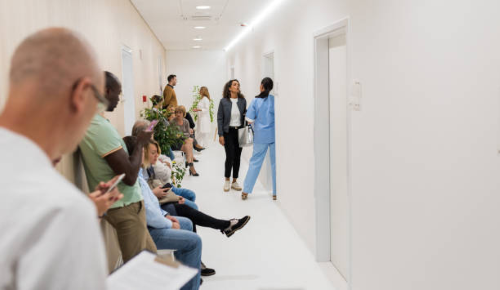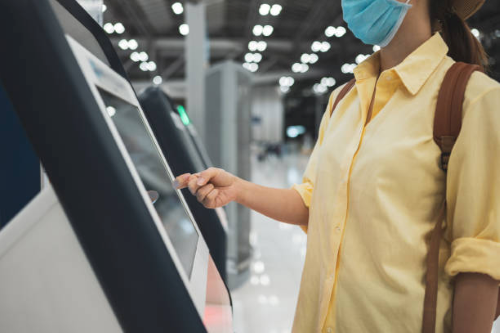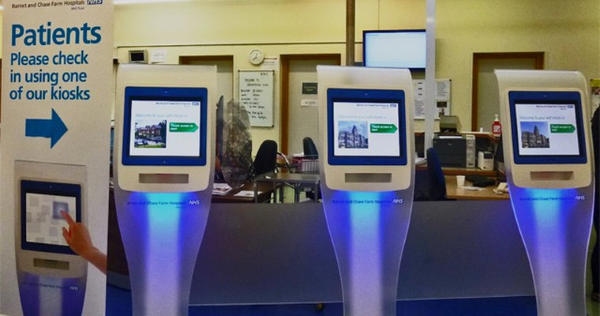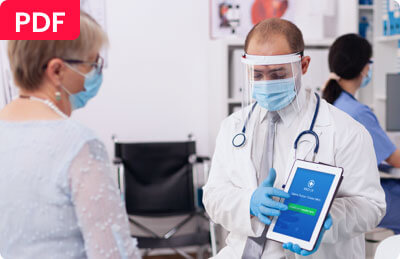- Lockdown device into single-app/multi-app mode.
- Remotely see device screen and troubleshoot anytime.
- Customize interface, layout and brand.
- Streamline Android app updates and manage multimedia files in bulk.
Medical Kiosks: Transforming Patient Care and Efficiency in Healthcare
Patients who visit a healthcare setting, such as a hospital, clinic, or pharmacy, feel unwell. They may be sick, exhausted, or even hurt. Unfortunately, the patient experience often worsens their condition.
Once they enter the healthcare setting, they must manually complete extensive paperwork. After taking a ticket from the dispenser, they have to sit on uncomfortable chairs in the waiting room, uncertain of their place in the queue. Rather than rest, they must also pay close attention to when their number is called or risk losing their appointment. To borrow an idiom, this kind of patient experience adds insult to injury: Patients are worse off than when they first came.
Healthcare organizations need to reimagine the patient experience for their patients’ sake and their business.
1. Current Situation
This status quo is operationally intensive
All the paperwork that patients complete must be manually filed or digitally encoded. The ticket dispenser, or take-a-number system, must be regularly maintained. The receptionist must also call out for the next patient, like a barker.
This work takes man-hours that healthcare professionals should instead spend on who matters the most: patients.

This status quo will affect patient retention
When patients are sick and in need of medical attention, they will likely stick through a lousy patient experience: They need immediate assistance, after all. However, this experience will inevitably color their view of the business, and they may seek alternatives next time.
No patient wants to continually endure a lousy experience when ill. They want to patronize healthcare businesses that think of their well-being when they walk through the door, not just when the medical professional sees them.
This status quo can harm the healthcare organization’s brand.
There have been more than a few instances in which patients have died in waiting rooms because the queuing systems are so inefficient. Such incidents understandably cause a wave of public scrutiny, such as the March 2023 case where a patient died while waiting to be seen at a Manitoba hospital.
These incidents mar the reputation of healthcare organizations, even if they may have good track records otherwise. Rather than be viewed as stewards of public and personal health, they are maligned as businesses that do not care enough to address how patients are first received.
While the effects of a bad patient experience are substantial, fixing them is surprisingly easy. Organizations can do away with a system revolving around tickets and paperwork. They can instead adopt patient check in tablet as touchpoints that receive customers, enable them to input information and provide status updates and other essential information.
2. Medical kiosks transform the patient experience
Medical kiosks are not a single-purpose technology for healthcare organizations. Instead, they can fulfill a variety of use cases for enterprises and their patients across the entire check-in process. In this way, they improve patient welfare by offering them a more convenient, seamless, and efficient user experience when they need it the most.

It is easy to assume that the hardware is the most critical part of medical kiosks. While the device specs are important - healthcare businesses will want attributes that match their intended use case - it is ultimately a minor step. The more critical factor is using an MDM, which provides the functionality necessary to manage the medical kiosk.
One top MDM for medical kiosks is AirDroid Business, which can help healthcare organizations every step of the way.
3. Medical kiosks create a seamless queuing experience
Medical kiosks can digitize the queuing system of healthcare settings. The most immediate benefit is time. Hospital staff no longer have to spend time corralling patients when their number is up since they can now view the queue progress on an overhead screen.
Patients, in turn, get a much better experience: They know precisely when they will be seen rather than wonder where they are in the queue. They also can rest more while waiting since they have to spend less energy listening intently for their number to be called. There is also the setting-appropriate benefit of reducing face-to-face contact that can spread airborne illness.
Unfortunately, some medical kiosks end up being counter-productive. As devices, they will inevitably glitch or go down. When this happens, healthcare businesses lose even more time: They may overlook the issue until a patient brings it to their attention, and then they will need to call an IT professional on-site to fix the problem.

In this way, a single, non-functioning medical kiosk can throw these front-end operations into chaos since the organization relies on it to check in patients.
This gap is where an MDM like AirDroid Business can help. Because these devices allow full device visibility, remotely and in real-time, IT teams would detect a problem almost immediately. From there, they can use AirDroid’s remote access feature to troubleshoot, fix the problematic kiosk, and return it to serving patients. AirDroid, in short, ensures that the queuing experience provided by medical kiosks is seamless and reliable.
4. Medical kiosks allow patients to input sensitive information
Medical kiosks can do more than check in patients and display queuing status - they can also serve as customer touchpoints for inputting sensitive information. This use case is a significant improvement from having patients fill out paperwork on a clipboard.

Patients get an all-around better experience. Since they are more accustomed to typing than handwriting, inputting their information into a medical kiosk will seem more natural. The process is also more efficient and less error-prone: Once they provide the necessary content, they do not need to wait for the receptionist to encode the information, which may result in inaccuracies from misreading handwriting. Patients may also feel more comfortable interacting with a kiosk for sensitive details compared to a human, such as requesting longer payment terms for a medical procedure.
Medical office check in kiosk enable customers to input this sensitive information, use other non-affiliated apps, or even browse the web. This ability is not a feature but a security risk. Patients who can freely access the internet may inadvertently click, download, or interact with malware that compromises their data.
Thankfully, an MDM can help here, too. With AirDroid, healthcare organizations can restrict access to their medical kiosks through single-app mode and an app whitelist. These features ensure that patients only access what they need to submit their required information, keeping them safe from the dangers of the open net.
5. Medical kiosks improve the patient experience
When considering implementing medical kiosks, most healthcare professionals assume that they only improve front-end operations: reception, queueing, data collection, and so forth. But improving these processes also benefits the patient experience when meeting a healthcare professional in several ways.
The first benefit can be witnessed in the patients themselves. When they meet with the doctor, nurse, pharmacist, or other medical professional in a more relaxed state, they can better perform their necessary duties as a patient.
These duties include articulating their symptoms, adhering to medical tests, and listening to the professional’s advice. Such seemingly simple tasks are complicated when the patient meets with the medical professional in a frustrated state resulting from a poor waiting experience.

Medical professionals also benefit. Because relevant data is inputted instantly into the healthcare organization’s information system - rather than passed around in files and folders - they can refer to relevant data to improve the patient experience. For example, a doctor may bring up records of the patient’s weight gain over the last to visually emphasize how they must rein in their eating and exercise more.
This personalization enhances the patient experience: Patients feel that medical professionals are catering to their specific needs. This sentiment is further aided by medical kiosks that collect additional medical data, such as blood pressure, through attached special hardware.
Because medical kiosks improve the entire patient experience, it is vital for healthcare organizations to brand them with their visual identity properly. That way, patients develop brand affinity toward the healthcare organization for providing medical kiosks that help them from the moment they walk through the door to when the medical professional gives their expert opinion.
Fortunately, an MDM like AirDroid Business makes branding much more manageable. With AirDroid’s Kiosk Mode, healthcare organizations can customize the logo and wallpaper to best reflect their brand. Patients will associate the healthcare organization with positive feelings, such as convenience, care, and fulfillment. In turn, these healthcare organizations will enjoy better retention, greater lifetime value, and even stronger word-of-mouth to friends and family of current patients.
6. Medical kiosks are only the first step
When healthcare organizations speak of digital transformation, they often focus exclusively on procuring new hardware, such as medical kiosks. This view addresses only one part of the equation. Equally important is the software.
Without a proper MDM, medical kiosks will frequently go down or glitch, be prone to security breaches, and fail to advance the healthcare organization’s branding. In contrast, healthcare organizations create a winning combination when medical kiosks are powered with an MDM like AirDroid Business.
Medical kiosks backed with an MDM will have minimal downtime due to full-device visibility and remote access. These touchpoints will also be secure from cybersecurity risks through the protection of single-app mode and app whitelists or blocklists. Finally, patients will enjoy a better experience interfacing with medical professionals because of greater personalization and convenience.
Healthcare organizations will build their reputation from this value because the medical kiosks are properly branded with their visual identity. Patients will rightfully view these healthcare organizations as not only courageous for leaping to digital but also as caring for doing it with the right combination of technologies.

AirDroid Business MDM For Healthcare
Efficiently manage a large number of medical mobile devices and update applications,regularly track device abnormal conditions toprovide timely remote support, and strengthenthe data security protection of patients andhospitals.





Leave a Reply.